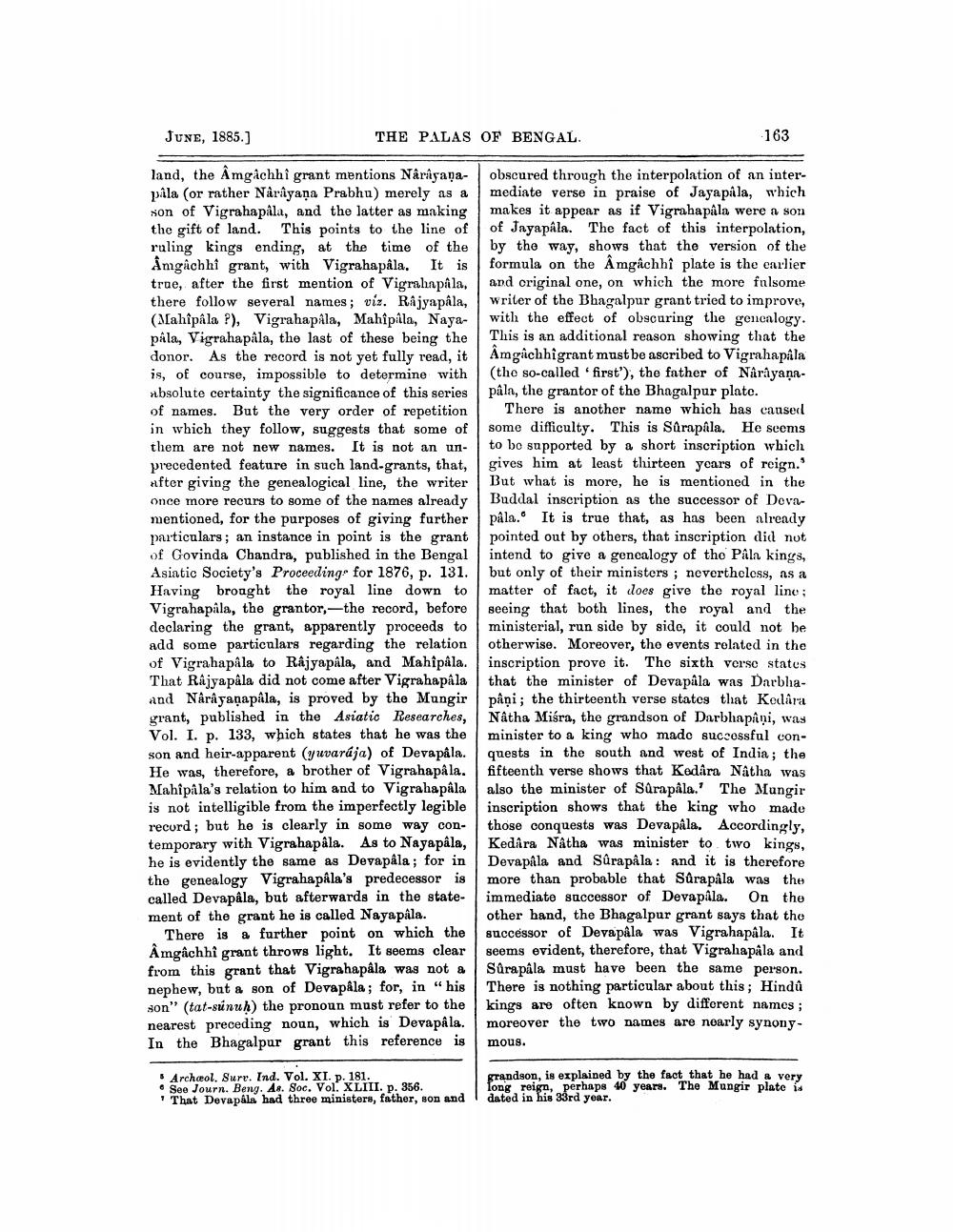________________
JUNE, 1885.]
THE PALAS OF BENGAL.
163
land, the Amgachhi grant mentions Narayana- obscured through the interpolation of an interpåla (or rather Narayana Prabhu) merely as a mediate verse in praise of Jayapala, which son of Vigrahapala, and the latter as making makes it appear as if Vigrahapala were a son the gift of land. This points to the line of of Jayapala. The fact of this interpolation, ruling kings ending, at the time of the by the way, shows that the version of the Ångachhi grant, with Vigrahapala. It is formula on the Amgâchhî plate is the earlier true, after the first mention of Vigrahapala. and criginal one, on which the more fulsome there follow several names; víz. Rajyapala, writer of the Bhagalpur grant tried to improve, Mahîpåla ?), Vigrahapala, Mahîpila, Naya- with the effect of obscuring the genealogy. påla, Vigrahapala, the last of these being the This is an additional reason showing that the donor. As the record is not yet fully read, it Ämgâchhigrant must be ascribed to Vigrahapala is, of course, impossible to determine with (the so-called 'first), the father of Narayaņaabsolute certainty the significance of this series pâla, the grantor of the Bhagalpur plate. of names. But the very order of repetition There is another name which has caused in which they follow, suggests that some of
some difficulty. This is Sarapala. He seems them are not new names. It is not an un- to bo supported by a short inscription which precedented feature in such land-grants, that, gives him at least thirteen years of reign.' ufter giving the genealogical line, the writer But what is more, he is mentioned in the once more recurs to some of the names already Buddal inscription as the successor of Dovamentioned, for the purposes of giving further pala. It is true that, as has been already particulars; an instance in point is the grant pointed out by others, that inscription did not of Govinda Chandra, published in the Bengal intend to give a genealogy of the Pala kings, Asiatic Society's Proceedingo for 1876, p. 131. but only of their ministers ; nevertheless, as a Having broaght the royal line down to matter of fact, it does give the royal lino; Vigrahapala, the grantor,—the record, before seeing that both lines, the royal and the declaring the grant, apparently proceeds to ministerial, run side by side, it could not be add some particulars regarding the relation otherwise. Moreover, the events related in the of Vigrahapala to Rajyapala, and Mahipala. inscription prove it. The sixth verse states That Rajyapala did not come after Vigrahapala that the minister of Devapala was Darbhaand Narayanapala, is proved by the Mungir påņi; the thirteenth verse states that Kodara grant, published in the Asiatic Researches, Nátha Miśra, the grandson of Darbhapaņi, way Vol. I. p. 133, which states that he was the | minister to a king who made successful conson and heir-apparent (yuvarája) of Devapala. quests in the south and west of India; the He was, therefore, a brother of Vigrahapala. fifteenth verse shows that Kedara Natha was Mahîpâla's relation to him and to Vigrahapala also the minister of Surapala.' The Mungir is not intelligible from the imperfectly legible inscription shows that the king who made record; but he is clearly in some way con- those conquests was Devapala. Accordingly, temporary with Vigrahapala. As to Nayapala, Kedara Nátha was minister to two kings, he is evidently the same as Devapala; for in Devapala and Sûra påla : and it is therefore the genealogy Vigrahapala's predecessor is more than probable that Sûrapala was the called Devapala, but afterwards in the state- immediate successor of Devapila. On the ment of the grant he is called Nayapala. other hand, the Bhagalpur grant says that tho
There is a further point on which the successor of Devapâla was Vigrahapala. It Amgachhi grant throws light. It seems clear seems evident, therefore, that Vigrahapala and from this grant that Vigrahapala was not a Sûrapala must have been the same person. nephew, but a son of Devapala; for, in “his There is nothing particular about this; Hindu son" (tat-súnuh) the pronoun must refer to the kings are often known by difforent names ; nearest preceding noun, which is Devapala. moreover the two names are nearly synonyIn the Bhagalpur grant this reference is
mous.
Archeol. Sure. Ind. Vol. XI. p. 181. • See Journ. Beng. As. Soc. Vol. XLIII. p. 356. "That Devapala had three ministers, father, son and
grandson, is explained by the fact that he had a very long reign, perhaps 40 years. The Mungir plate is dated in his 33rd year.




